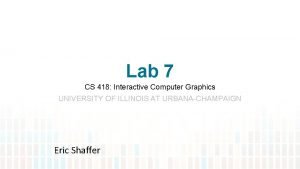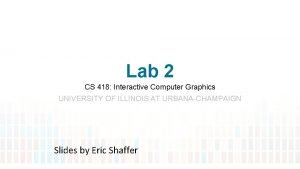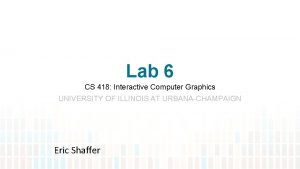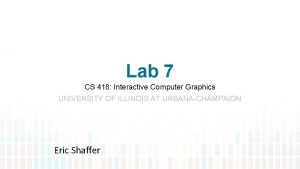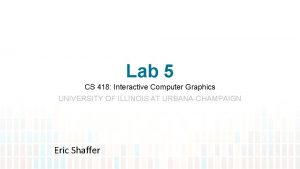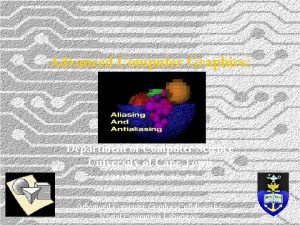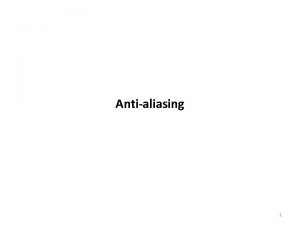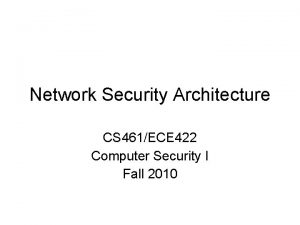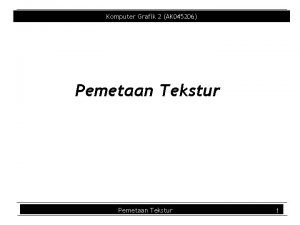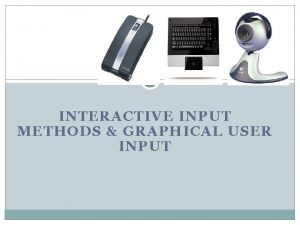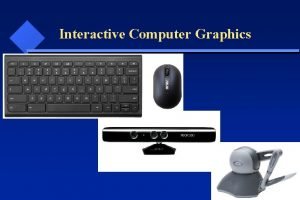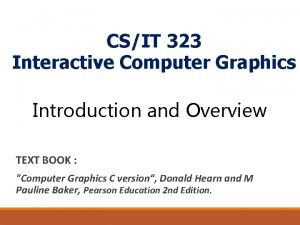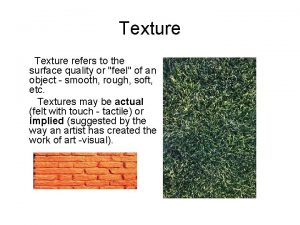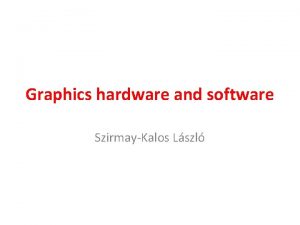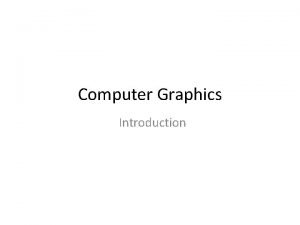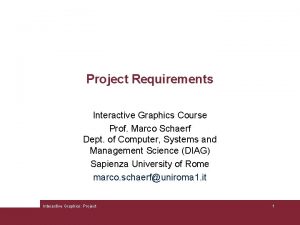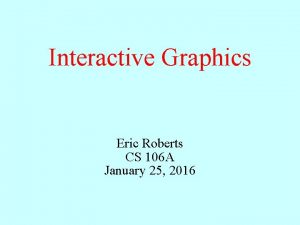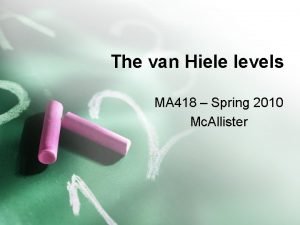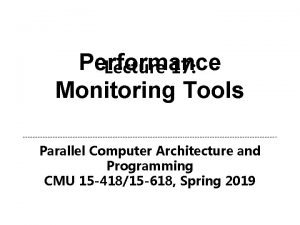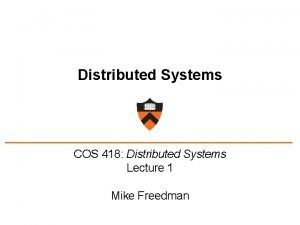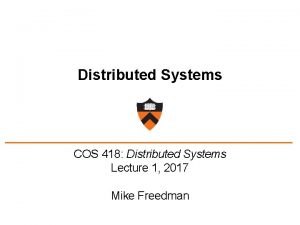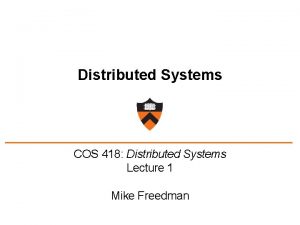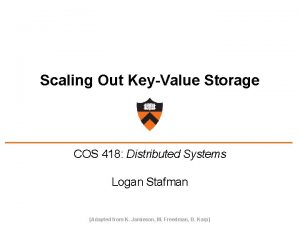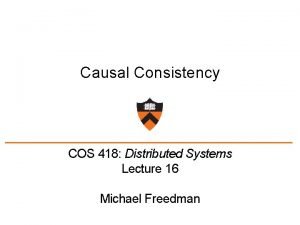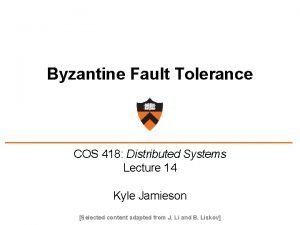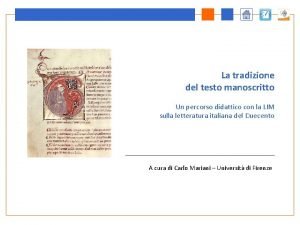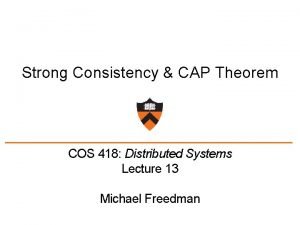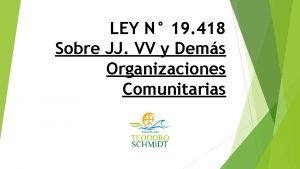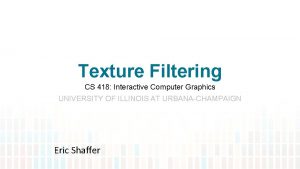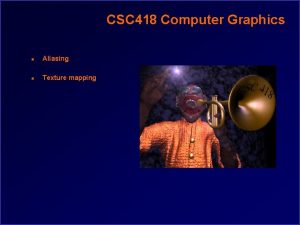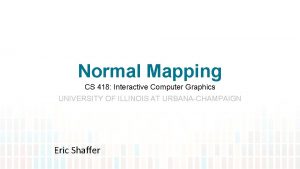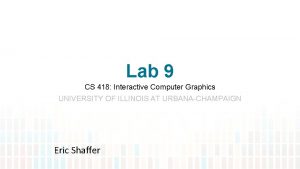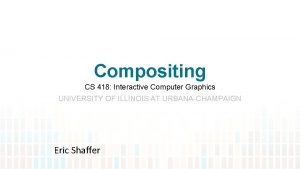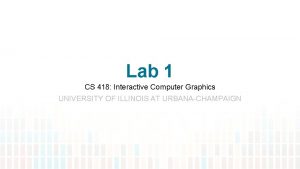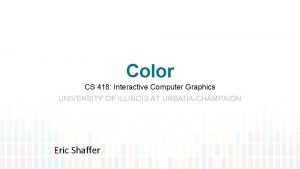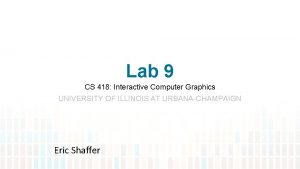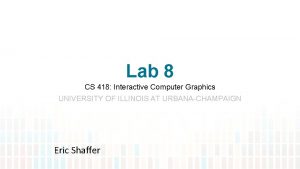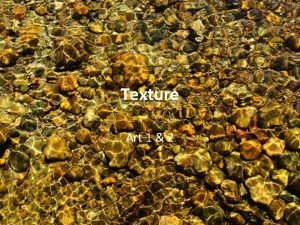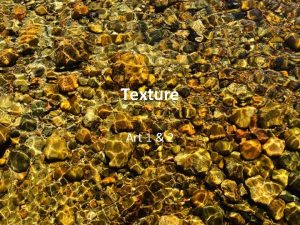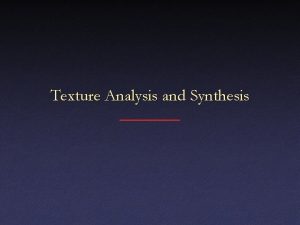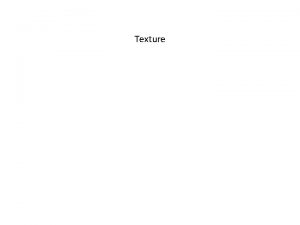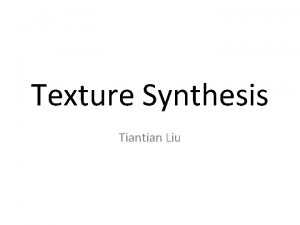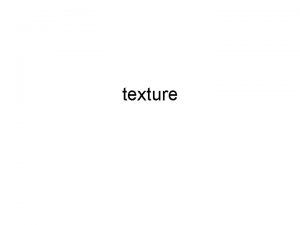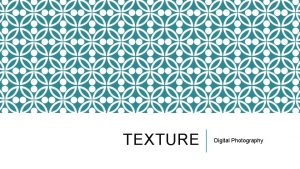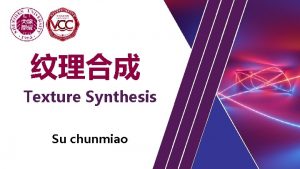Texture Filtering CS 418 Interactive Computer Graphics UNIVERSITY






























- Slides: 30

Texture Filtering CS 418: Interactive Computer Graphics UNIVERSITY OF ILLINOIS AT URBANA-CHAMPAIGN Eric Shaffer

Reviewing Texture Coordinates • We’re using the following convention: • (u, v) are the texture coordinates assigned in the parametric space with u and v in [0, 1] • (s, t) are the texel coordinates in a texture • …. some people use (s, t) to denote the parametric coordinates…

Match the Coordinates to the Image Match each textured quad with the set of texture coordinates used to generate it given in the list below. For the quad, the upper left vertex is number 0 and the vertices are enumerated clockwise around the quad.

For example • The first image is axis aligned and doesn’t repeat • Only possible coordinates from list are • Which give axis-aligned edges • And parametric lengths of 1

Texture Coordinates • We’ve only looked at simple mappings • Mapping the texture onto planar surfaces • More complicated surfaces need more complicated mappings

Example: Mapping onto a sphere Sphere on the right uses: How is the sphere on the left being textured?

Perspective Correct Coordinates • Linear (affine) interpolation problematic for texture coordinates • …and we need per-fragment coordinates • Won’t produce perspective correct texture coordinates

Perspective Correct Coordinates -- Wikipedia

Texture Filtering • We often have a mismatch between texture size and number of fragments • Requires us to adjust how the texture is sampled… • This more complicated sampling process is called texture filtering • Magnification occurs when we have more fragments than texels • Minification occurs when we have more texels than fragments • Two common mag filters • Nearest Neighbor • Bilinear • Most common min filter • Mipmapping

Magnification Examples

Magnification: Nearest Neighbor

Magnification: Bilinear Interpolation • In bilinear interpolation, we estimate a value for a function • On a 2 D grid…with function samples at the grid vertices • We interpolate first in one direction (e. g. the x direction) • Interpolate using linear interpolation twice • Find 2 points…one on each edge • Then interpolate in the other direction (e. g. the y direction) • Linear interpolation again • Between the two points from the first round of interpolation

Magnification: Bilinear Interpolation

Filtering Textures • Minification occurs when we have more texels than fragments • Using NN or Bilinear Filtering can lead to aliasing • Why? • What would a better strategy be? • What is the maximum number of texels fetched per fragment?

Filtering Textures • Minification occurs when we have more texels than fragments • Using NN or Bilinear Filtering can lead to aliasing • Why? • Sparse sampling will can cause us to miss features • e. g. a checkerboard pattern could be turned into solid color • What would a better strategy be? • Average all of the texels that map into a fragment • What is the maximum number of texels fetched per fragment?

Minification

Mipmapping • Mipmapping is a method of pre-filtering a texture for minification • History: 1983 Lance Williams introduced the word “mipmap” in his paper “Pyramidal Parametrics” • mip = “multum in parvo”…. latin: many things in small place(? ) • We generate a pyramid of textures • Bottom-level is the original texture • Each subsequent level reduces the resolution by ¼ (by ½ along s and t)

Mipmapping

Pre-filtered Image Versions • Base texture image is say 128 x 128 • Then down-sample 64 x 64, 32 x 32, all the way down to 1 x 1 Trick: When sampling the texture, pick the mipmap level with the closest mapping of pixel to texel size Why? Hardware wants to sample just a small (1 to 8) number of samples for every fetch—and want constant time access

Creating a Mipmap • In Web. GL you can manually generate and upload a mipmap • Or you can have Web. GL generate it for you gl. generate. Mipmap(GL_TEXTURE_2 d) • Usually, bilinear filtering is used to minify each level • …but that’s up to the implementation of the library

Level of Detail Selection

Mipmap Level-of-detail Selection • Hardware uses 2 x 2 pixel entities • Typically called quad-pixels or just quad • Finite difference with neighbors to get change in u and v with respect to window space • Approximation to ∂s/∂x, ∂s/∂y, ∂t/∂x, ∂t/∂y • Means 4 subtractions per quad (1 per pixel) one-pixel separation

Mipmap Level-of-detail Selection • Hardware uses 2 x 2 pixel entities • Typically called quad-pixels or just quad • Finite difference with neighbors to get change in u and v with respect to window space • Approximation to ∂s/∂x, ∂s/∂y, ∂t/∂x, ∂t/∂y • Means 4 subtractions per quad (1 per pixel) • Now compute approximation to gradient length • p = max(sqrt((∂s/∂x)2+(∂t/∂x)2), sqrt((∂s/∂y)2+(∂t/∂y)2)) one-pixel separation 23

Level-of-detail Bias and Clamping • Convert p length to level-of-detail • λ = log 2(p) • Now clamp λ to valid LOD range • λ’ = max(min. LOD, min(max. LOD, λ)) 24

Determine Mipmap Levels • Determine lower and upper mipmap levels • b = floor(λ’)) is bottom mipmap level • t = floor(λ’+1) is top mipmap level • Determine filter weight between levels • w = frac(λ’) is filter weight 25

Web. GL Computing a Color from a Mipmap Web. GL offers 6 ways to generate a color from a mipmap NEAREST = choose 1 pixel from the biggest mip LINEAR = choose 4 pixels from the biggest mip and blend them NEAREST_MIPMAP_NEAREST = choose the best mip, then pick one pixel from that mip LINEAR_MIPMAP_NEAREST = choose the best mip, then blend 4 pixels from that mip NEAREST_MIPMAP_LINEAR = choose the best 2 mips, choose 1 pixel from each, blend them LINEAR_MIPMAP_LINEAR = choose the best 2 mips. choose 4 pixels from each, blend them

Mipmap Texture Filtering 27

Web. GL: Highest Quality Filtering gl. tex. Parameteri(gl. TEXTURE_2 D, gl. TEXTURE_MIN_FILTER, gl. LINEAR_MIPMAP_LINEAR); gl. tex. Parameteri(gl. TEXTURE_2 D, gl. TEXTURE_MAG_FILTER, gl. LINEAR); Although some Web. GL implementations may now support anisotropic texture filtering…which is even better

Web. GL: Non-power of 2 textures • You should use textures that are 2 k x 2 k • You can use textures that are not powers of two • but must • set the wrap mode to CLAMP_TO_EDGE • turn off mipmapping by setting filtering to LINEAR or NEAREST…

Texture Arrays • Multiple skins packed in texture array • Motivation: binding to one multi-skin texture array avoids texture bind per object Texture array index Mipmap level index 0 1 2 3 4 30 3 4
 Cs 418 interactive computer graphics
Cs 418 interactive computer graphics Glcreatebuffer
Glcreatebuffer Uiuc cs 418
Uiuc cs 418 Cs 418 interactive computer graphics
Cs 418 interactive computer graphics Cs 418 interactive computer graphics
Cs 418 interactive computer graphics James gain
James gain Weighted area sampling
Weighted area sampling Ingress filtering vs egress filtering
Ingress filtering vs egress filtering Pemetaan tekstur
Pemetaan tekstur What are the interactive input methods? explain in detail.
What are the interactive input methods? explain in detail. What are the components of interactive computer graphics
What are the components of interactive computer graphics The component of interactive computer graphics are
The component of interactive computer graphics are Interactive computer graphics examples
Interactive computer graphics examples Graphics monitor and workstation in computer graphics
Graphics monitor and workstation in computer graphics Graphics hardware in computer graphics ppt
Graphics hardware in computer graphics ppt The tactile quality of a surface
The tactile quality of a surface Interactive graphics software and hardware
Interactive graphics software and hardware Calligraphic refresh graphics display
Calligraphic refresh graphics display Interactive graphics sapienza
Interactive graphics sapienza Interactive graphics utah
Interactive graphics utah Ma-418-0-0-4
Ma-418-0-0-4 Cmu 15-418
Cmu 15-418 Cos 418
Cos 418 Cos 418
Cos 418 Cos 418 spring 2021
Cos 418 spring 2021 Cos 418
Cos 418 Cos 418
Cos 418 Cos 418
Cos 418 Banco rari 217
Banco rari 217 Cos418
Cos418 Ley 19 418
Ley 19 418
